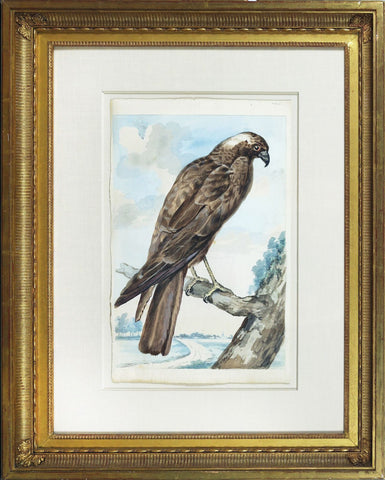
Cornelius Nozeman (Dutch, 1712-1786), “Birds Perched on a Branch”
Jan Christian Sepp (Dutch, 1739-1801)
and Christiaan Andreas Sepp (Dutch, C.1700-1775)
for Cornelius Nozeman (Dutch, 1712-1786)
“Birds Perched on a Branch”
Prepared for Nederlandsche Vogelen; volgens hunne huisdouding, aert, en eigenschappen beschreeven. Amsterdam: Jan Christian Sepp, 1770-1829
Watercolor, gouache and pencil on paper
ca. 1770
Paper size: 16 1/4 x 12 in.
Framed size: 24 x 20 3/4 in.
Widely distributed throughout British Isles mainly sedentary but numbers considerably increased in autumn with passage migrants and winter-visitors from the continent. In the original volumes of Nederlandsche Vogelen the plate shows the birds with a nest and eggs and is titled in old Latin Motacilla Rubecula.
Cornelius Nozeman was born in Amsterdam to the composer Jacobus Nozeman. He was trained as a preacher and called to Alkmaar, where he served 1744-1749 and 1749 Haarlem. While in Haarlem, Nozeman gathered his cabinet of fish and fossils and developed an affinity for ornithology. In 1759 Nozeman was called to serve in Rotterdam, and it was there that he began preparations for his great work on Nederlandsche Vogelen (Birds of the Netherlands). This monumental work was published in installments by Christiaan Sepp, starting in 1770.
Nozeman’s Nederlandsche Vogelen was the first comprehensive account of the avifauna of Holland. Published in five parts between 1770 and 1829 by the Sepp family, the volume’s 250 plates depict 192 species of bird found in North and South Holland in the late eighteenth century. Nederlandsche Vogelen was published over a long time, and Nozeman died before the second part was published, leaving physician Martinus Houttuyn as his successor.
All species were “drawn as they are in life,” and many depicted in their actual size. The plates frequently feature eggs and nests, and a few are dedicated exclusively to those subjects. Jean Anker’s definitive catalogue of bird books praises the Nozeman publication for depicting the birds “in their natural surroundings and as far as possible in their natural attitudes.” Another scholar, Sacheverell Sitwell, calls Nederlandsche Vogelen “an ornament to the age of Rococo.”
or by email at loricohen@aradergalleries.
We Also Recommend





